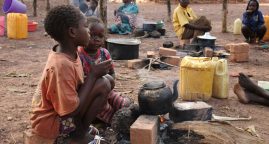When Food Shortage Becomes Famine
The canoe was not big enough to carry them all. Peter Met Biel Luak, his wife, her mother and his 10 children needed to travel through the swamp to escape.
Some had to swim or walk through chest-deep water. They had no food, no blankets, no mosquito nets.
“I left nothing behind,” said Peter Luak. “My house was burned down and my cows and belongings were all looted.”
Luak and his family were forced to flee their home in August 2015, when fighting between government and rebel forces decimated their town of Leer.
After three days of wading through a web of narrow canals that traverse the Sudd, one of the largest swamps in the world, they found Ghouyman, a small island where a few other families had taken shelter.
Luak and his family are among the more than 2.8 million people in South Sudan — nearly a quarter of the country’s population — who are currently facing food shortages and need urgent assistance according to the United Nations. The U.N. is now warning of a looming famine.
When to Use the F-Word
Famine is a technical term. It is a data-based scientific classification of the level of food insecurity in a particular area. The threshold for famine is intentionally set high, and these days, cases of famine are rare. A famine declaration is supposed to trigger a swift and comprehensive intervention by aid organizations to deliver food and medicine to people who are close to death by starvation.
But it hasn’t always worked that way. Before a standardized system to analyze food crises was widely adopted, aid groups, governments and donors struggled to decide if, when and how to respond to emergencies.
The issue came to a head in 2004, when a hunger crisis was unfolding in Somalia. At the time, various international agencies working in Somalia used different indicators to evaluate the food security situation and sometimes published conflicting information, said Cindy Holleman, who worked for the U.N. Food and Agriculture Organization’s Food Security and Analysis Unit in Somalia.
“Decision-makers were having trouble understanding which is the right information,” Holleman said, because there was no standardized, centralized system to measure the scale and severity of food shortages.
The lack of a common language with which to describe food shortages also interfered with the ability to coordinate an effective response, according to Chris Hillbruner of the Famine Early Warning Systems Network, a project of the U.S. Agency for International Development.
“There would be a situation, and I’m calling it a crisis, and you’re calling it a disaster, and Joe’s calling it an emergency, and someone else is calling it a famine. And it was very unclear whether we were actually saying different things or not,” Hillbruner said.
In 2004, the U.N. Food and Agriculture Organization, along with other humanitarian agencies, created the Integrated Food Security Phase Classification (IPC), a set of protocols to analyze and classify the severity of food insecurity. The IPC was updated in 2009, and the 2.0 version is widely used today.
“A New Brutality”
South Sudan’s food crisis is entirely man-made. In December 2013, two years after the country gained independence, a power struggle between President Salva Kiir and his former vice president, Riek Machar, launched the young country into civil war.
What began as fighting between two army factions in the capital quickly spread to other parts of the country. Machar’s rebel forces took control of large parts of Unity state, an area loyal to the former vice president, including Leer, where the Luak family lived.
In April 2015, the government launched an offensive to retake rebel-held areas. Across Unity state, its forces burned down entire villages, destroyed food crops and looted livestock, sparking mass displacement of the survivors, according to the U.N.
“There are indications that this may have been a deliberate strategy by the government or the SPLA [South Sudanese military] aimed at depriving civilians of any source of livelihood with a view to forcing their displacement,” a U.N. human rights report said.
Government officials deny the allegations.
“That’s not true,” Ateny Wek, President Salva Kiir’s spokesman, told FRONTLINE. “For anybody to think that the SPLA is killing people or taking cows, this is an exaggerated statement, a statement aimed at just tarnishing the image of the SPLA.”
A June 2015 report by the U.N. peacekeeping mission in South Sudan documented widespread allegations of civilian killings, rape and abduction. The report noted “a new brutality and intensity, including such horrific acts as the burning alive of people in their homes.”
Like the Luak family, thousands of civilians fled into swamps to escape the violence, “only to be hunted down by armed attackers in their places of hiding,” according to a report by aid groups working in South Sudan.
Despite an August ceasefire signed by Kiir and Machar, ongoing violence has forced more displacement and deepened food insecurity.
Read the full article on Frontline website
Related Articles
Joint Statement Urging More Aid, Solidarity and Attention to Sudan Crisis
13/09/2023. We, the heads of over 50 human rights and humanitarian organizations are coming together to sound the alarm about Sudan, where a disaster is unfolding before our eyes.
South Sudan: UN report exposes human rights violations against civilians in Yei
05/19/2017. “The conflict highlights the startling level of impunity in South Sudan, which has fed successive cycles of violence across the country,”
Fixing the world’s humanitarian crises
05/18/2016. Christos Stylianides is the EU Commissioner for Humanitarian Aid and Crisis Management.






